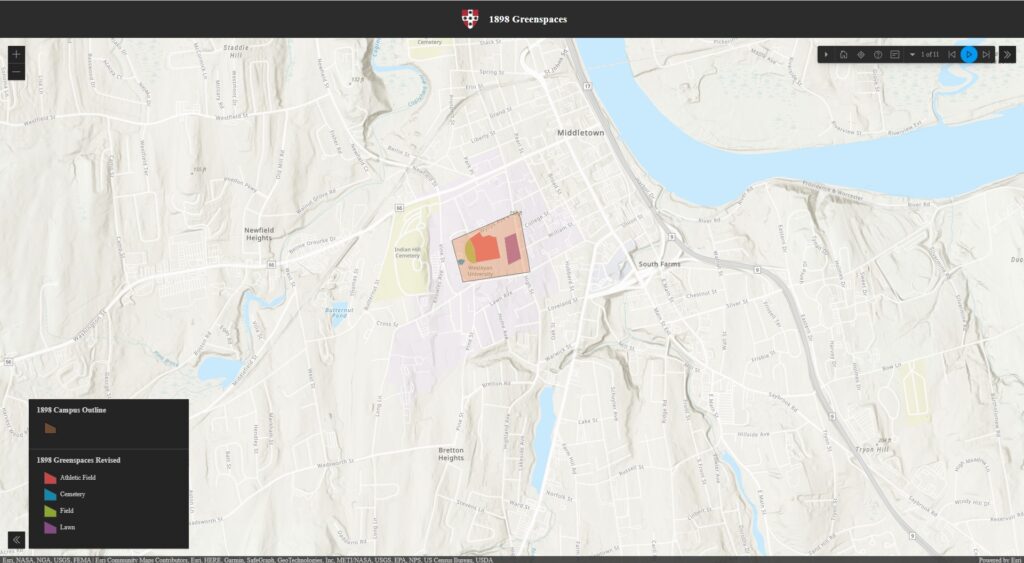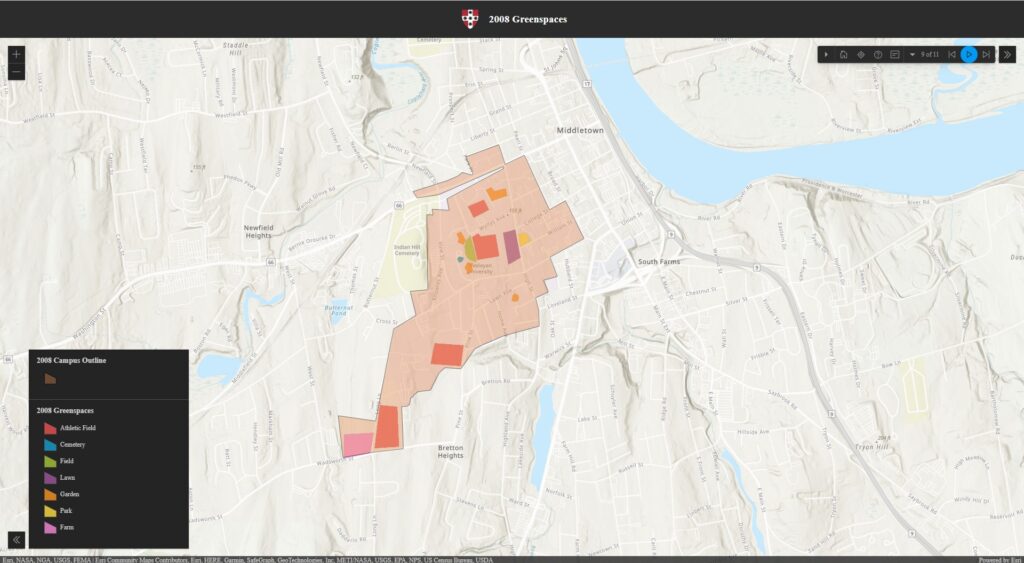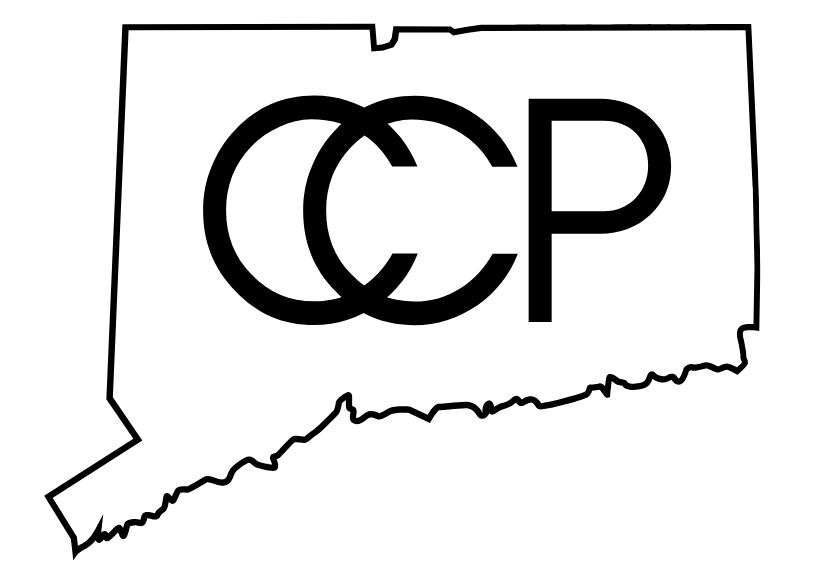Mapping Greenspace at Wesleyan University
By Jonah Barton, Emma Steckline, and Abby Lyell
Project Justification
Our project, Mapping Greenspace at Wesleyan University seeks to chronicle how campus grounds have expanded over time and how greenspace has changed with that. We see greenspace as a part of campus structure that was intentionally placed for use by students rather than a passively accepted expanse. Everything about the area that Wesleyan owns is intentional, being that they have bought many buildings and land in the surrounding Middletown area and consistently have made plans for the space as a whole to fulfill the mission of the university. We define greenspace as any park, field, farm, lawn, garden, cemetery, athletic field, or forest (where they still exist) that is usable by both Wesleyan students and members of the community.
For our map, we have chosen flashpoint years starting in 1898 (when Andrus field, one of the most central and spacious greenspaces on campus, was built) to 2023. These years highlight major campus changes wrought by construction and expansion. Most of the data that we used to identify these flashpoints came from campus planning documents, proposals, and maps. From the proposals, we were also able to identify the desire of campus planners and administrators for greenspace as an integral part of their ideal aesthetic. Through visualizing changes in Wesleyan’s land ownership and use of that land we hope to provide a basis for critique of the ethics of expansion into Middletown and the impacts of private university control on public access to greenspace. We see Wesleyan as a historical actor which exercises power through its control of land in Middletown rather than an inevitable or stagnant structure.
Land ownership by private holders is contested in its ethics but nonetheless is integral to how place is mediated between institutions and individuals and thus must be reckoned with. Within privately held lands specifically by universities (public universities as well) greenspace has been demonstrated to have a positive impact on students’ perceptions of their campus and additionally that students actively use these spaces as an integral part of their day-to-day life.
Though there is still much work to be done to fully realize our investigative goals, we have nonetheless identified some takeaways and claims that are central to the mission of our project. First of all, we believe it is of no small importance that the codification and designation of spaces (and their intended use) by the university alters the availability and accessibility of that space to the public. Second of all, it is evident from our research and personal experience as students on this campus that the way land ownership and actual uses of green space change is largely influenced by the institutional desires of Wesleyan and the changing shape and needs of the student body. Furthermore, greenspace on campus is important because it is so significant to the creation of an idealized campus, a campus that is advertisable.
Continuing with this project, we would like to collect even more data to more deeply investigate the aspect of how the changing student body concretely impacted the structural and spatial needs of the university. We would also like to collect more information about trees around campus since that aspect of our project turned out to be something that was a lot harder to find expansive data for than we expected. Generally, there are a lot of places where our data could be more inclusive but we were limited by the materials we had access to and the time we had to find them and what our sources deemed as a notable greenspace (mostly, those that are named). To make our visualization more robust, we would also like to add specific information about greenspaces and trees so that users can select a point or polygon and see a pop-up of more detailed information and photos of the space. We would hope to work with Wesleyan’s Jewett Center for Community Partnerships to participate mindfully and effectively with community organizations. Specifically, it is important to be intentional with understanding the ways that greenspaces are both created and destroyed, and how their presence impacts community members. Some possible community partners we identified to be particularly relevant to our research were The Rockfall Foundation (https://rockfallfoundation.org/about-us/) and the North End Action Team (https://neatmiddletown.org/). The Rockfall Foundation supports environmental education and conservation in the Lower Connecticut River Valley and aims to promote meaningful experiences and connections with nature. The North End Action Team works with residents of Middletown’s North End neighborhood to provide a pedestal for community members to have their voices heard through outreach and collaboration. Furthermore, they facilitate a community garden and improve community greenspaces.
Bibliography
- Cambridge Seven Associates, Inc. Development Strategies, September 1985: Wesleyan University Physical Education Facilities Study. Cambridge: Cambridge Seven Associates, Inc, 1985.
- Davis, Steven. In Defense of Public Lands: the Case Against Privatization and Transfer. Philadelphia: Temple University Press, 2018.
- Speake, Janet, Sally Edmondson, and Haq Nawaz. “Everyday Encounters with Nature: Students’ Perceptions and Use of University Campus Green Spaces.” Human Geographies 7, no. 1 (2013): 21–31.
- Wesleyan University. Guidelines and Recommendations for Campus Planning. Middletown, Connecticut: Wesleyan University, 1969.
Source Maps
- Campus Development, (1891-1907)
- General Plan of Wesleyan University, Middletown, Conn., Showing Present and Proposed Buildings, (1913)
- Map of Wesleyan University, Middletown, Conn. (1932)
- Wesleyan University Map of Campus (1963)
- Wesleyan University 1969-1970 Campus Map
- Wesleyan University: The Next Decade, (1974)
- Development Strategies: September 1985, Wesleyan University Physical Education Facilities Study
- Wesleyan University Tree Planting Plan (1994)
- Wesleyan University Walking Tour, (2004) Wesleyan University Campus Map, (2023)


